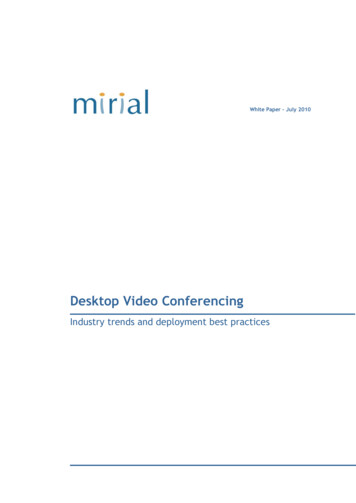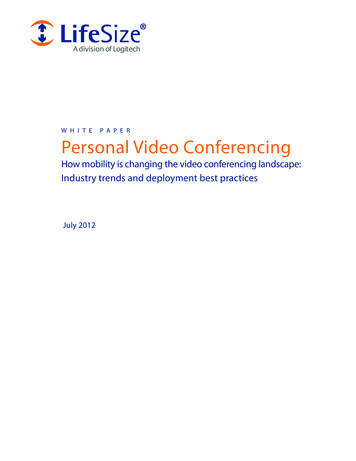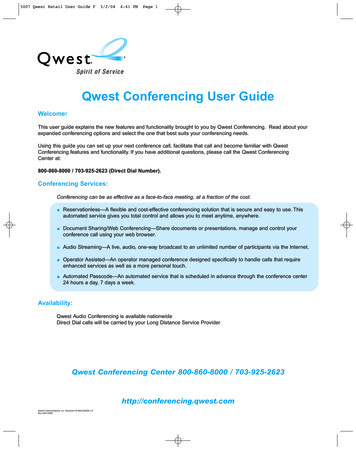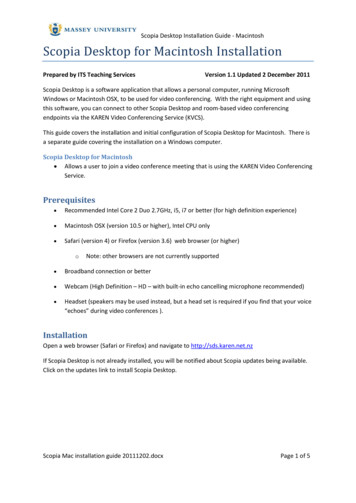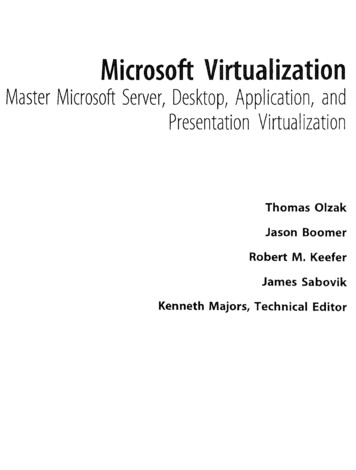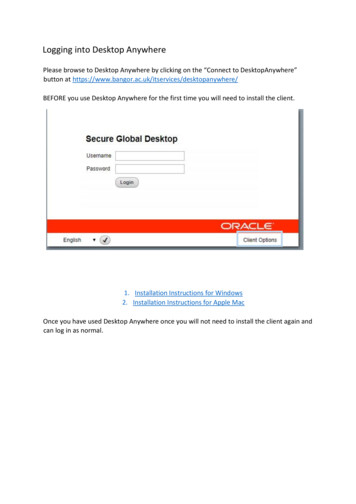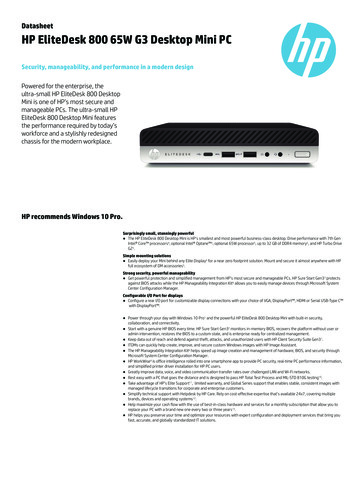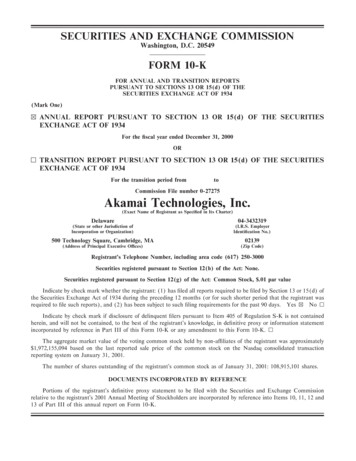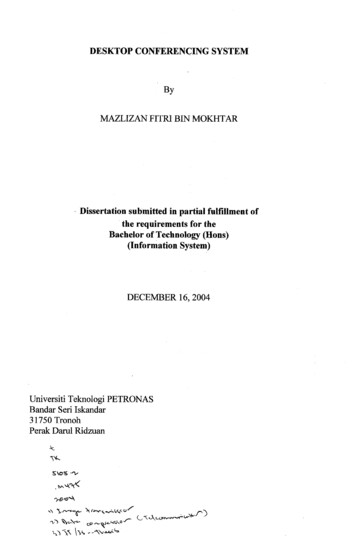
Transcription
DESKTOP CONFERENCING SYSTEMByMAZLIZAN FITRI BIN MOKHTAR· Dissertation submitted in partial fulfillment ofthe requirements for theBachelor of Technology (Hons)(Information System)DECEMBER 16, 2004Universiti Tekno1ogi PETRONASBandar Seri Iskandar31750 TronohPerak Daru1 Ridzuan \0 .,.' '-\" ( '}-S"'"''\'\, 'V'I y.1.,,-,'\ \ ' ' .;f"'V- -.A"N-"/"" ' t/-.0-'- -"\ L,. )( ,"\ -\ ""'.
CERTIFICATION OF APPROVALDesktop Conferencing SystembyMazlizan Fitri Bin MokhtarA project dissertation submitted to tbeInformation System ProgranuneUniversiti Teknologi PETRONASin partial fulfillment of the requirement for theBACHELOR OF TECHNOLOGY (Hons)(INFORMATION SYSTEM)Approved by,(Mr. Anang Hudaya Muhamad Amin)UNIVERSITI TEKNOLOGI PETRONASTRONOH, PERAKDEC2004
CERTIFICATION OF ORIGINALITYThis is to certify that I am responsible for the work submitted in this project, that theoriginal work is my own except as specified in the references andacknowledgements, and that the original work contained herein have not beenundertaken or done by unspecified sources or persons.MAZLIZAN FITRI BIN MOKHTAR
ABSTRACTUp until recently the whole area of video conferencing has proved to be an expensiveand tricky technology to be working with. Most of the video conferencing technologiescan be found in a large room video conferencing system with sophisticated andexpensive conferencing equipments. And in other hand, teaching and learning process isstill limited by physical boundaries. The main idea of this project is to improvecommunication and correlation among students, lecturers and tutors. The methodologychosen for the development of this project is Prototyping system developmentmethodology. It consists of Requirement Analysis, Design Prototype, EvaluatePrototype and Project completion. In Requirement Analysis Phase, the requirements ofthe application and the functional specification are determined followed by DesignPrototype Phase where all the critical part of this project is developed. These include theGraphical User Interface (GUI) development and the coding of this application. Thethird phase is Evaluate Prototype Phase where the testing phase took place. Each subcomponent is tested to make sure it met all requirements. Once all components of theapplication is tested and all requirements are satisfied, the last phase, that is ProjectCompletion Phase are considered completed whereby final documentation are to bedeveloped before the final presentation. As a conclusion, this project aims to improvecurrent communication style. It consumes communication technology effectivelywhereby the processing power of desktop computers has almost reached a level tobecome comfortable with processing the multimedia data. In addition, advances in thebandwidth availability on the internet and on LAN's/ WAN's has given the networks theability to handle the real time streaming media data.i
ACKNOWLEDGEMENTBismillah ar-Rahmani Ar-RaheemIn the Name ofAllah, The Most Compassionate, the Most MercifulIn order to complete this report, I have been doing researches over internet and readingmaterials over video conferencing technologies. In this Desktop Video Conferencingproject, I would like to thank:1. Mr. Anang Hudaya bin Muhamad Amin, my supervisor (for giving me theguidelines and ways in producing a good output and full support in terms ofknowledge input along this internship)2. The Backbone of FYP Committee - Mr. Mohd Nor Ibrahim and Ms Vivien,and all IT/IS lecturers, (for giving full commitment in term of providing infoabout the fmal year project)3. Universiti Teknologi PETRONAS- all UTP staff (for the full cooperation andproviding me very convenient places to complete the project with the providedutilities)4. My parents, Mr. Mokhtar bin Murad and Mrs Uzaiyah binti Yakob and familywho supports me fmancially and mentally5. Friends, for their support and information over my Final Year Project6. Those who involved directly and indirectly towards the project.11
TABLE OF CONTENTSABSTRACT .IACKNOWLEDGEMENT .nTABLE OF CONTENT.111LIST OF FIGURES.vABBREVIATIONS AND NOMENCLATURES.v1CHAPTER 1:INTRODUCTION.11.1Background ofStudy.11.2 Problem Statement.21.2.1Sophisticated and Expensive ConferencingEquipment.21.2.2 Teaching and Learning Process Limited byPhysical Boundaries1.2.3 Rapid Technology Evolvement.3Objective.31.4 Scope ofStudy.4LITERATURE REVIEW AND THEORY.52.1Video Conferencing Technologies.52.1.1Types of Video Conferencing. . .52.1.2 The H.323 Video Conferencing Standard.71.3CHAPTER2:22.2 Media Capture and Compression Technology.2.2.110Codec- compression/decompression.102.2.2 Audio Capture.122.2.3Audio Quantizing.122.2.4 Audio Compression.132.2.5 Video Capture.142.2.6 Video Compression Techniques.15111
CHAPTER3:2.2.7 Video Codec's.16METHODOLOGY ANDPROJECTWORK .183.1Userlnterface Design.183.2 Project Methodology.213.3 Tools Required.253.3.1CHAPTER 4:Hardware Requirements.253.3.2 Software Requirements.25RESULTS AND DISCUSSION.264.1 Functional Specification.264.1.1CHAPTER 5:Functional Specification for Client.264.1.2 Functional Specification for Server.374.2 Discussion on Port Control Issues.39CONCLUSION AND RECOMMENDATION.455.1 Conclusion.455.2 Recommendation. 46REFERENCES .48APPENDICES.49IV
LIST OF FIGURESFigure 2.1:H.323 Video ConferencingFigure 3.1:Graphical Presentation ofPrototyping MethodologyFigure 3.2:Initial prototype designFigure 3.3:Actual prototype designFigure 4.1:Actions available after starting the client applicationFigure4.2:Options available after capturing mediaFigure 4.3:Functions available after logging into the serverFigure 4.4:Functions available while in a group conferenceFigure 4.5:Functions available while chattingFigure 4.6:Functions available after starting the server applicationFigure 4.7:Administration of portsFigure 4.8:Scenario on port control issuesv
ABBREVIATIONS AND NOMENCLATURESGUIGraphical User InterfaceLANLocal Area NetworkWANWide Area NetworkMCUMultipoint Control UnitvcVideo ConferencingPCMPulse Code ModulationLPCLinear Predictive CodingGSMGroup Special MobileRTPReal-Time Transport ProtocolRTCPReal- Time Control ProtocolJMFJava Media FrameworkRGBRed, green, blueNIGNumbers in groupvi
CHAPTER IINTRODUCTION1. INTRODUCTIONChapter 1 explains the fundamental information of the project, which consists ofbackground of study, problem statement, objective and scope of the project. A briefexplanation of video conferencing also included in this section.1.1 Background of StudyThis report is written as a pre-requisite for undergraduate students to completethe studies Desktop video conferencing system is chosen for my title for the final yearproject as it could help me to enhance and in-depth with all the theories I have learntduring my years of studies.Desktop video conferencing began over a decade ago with the introduction ofexpensive group of video conferencing systems. It was designed to send and receivecompressed audio over dedicated links that could pledge predictable service. Standardson how the conferences were to be organized and how the video/audio streams were totravel over the network eventually evolved, but initially the systems were not veryinteroperable. These systems evolved and a common set of video conferencingstandards, H320, emerged. However these standards limited users to the expensiveequipment and facilities required for these standards. The user had the option topurchase the expensive equipment or to travel to special video conferencing enabledmeeting rooms to communicate. Although these large specialist systems are stillprevalent, the evolution of networks, standards and desktop computing power hasallowed mid level or low level desktop systems to enter the arena and compete toprovide simple and useful desktop video conferencing solutions.1
1.2Problem StatementUp until recently the whole area of video conferencing has proved to be an expensiveand tricky technology to be working with. It was not always worth to bother or spendmoney to implement such solutions when other communicating and collaboratingoptions appeared more beneficial. Until now, most videoconferencing was done withroom videoconferencing systems, which use very sophisticated and expensiveequipment to provide high-quality sound and video. As a solution, Desktop VideoConferencing was introduced which is less expensive and use personal computer.1.2.1Sophisticated and Expensive Conferencing EquipmentMost videoconferencing technologies were done with large room video conferencingsystems, which use very sophisticated and expensive equipment to provide high qualitysound and video. The desktop video conferencing experience is often of much lowerquality. Because of technical restrictions in sending video from one computer toanother, the image in desktop videoconferencing is typically not the size of your wholescreen, and the image quality won't be comparable to television. Although lacking in thearea of quality, the novelty value of video accompanying voice and text has been provedpopular on the internet. There are now many chat rooms on the internet with option toinclude your video as well as voice. This can be very slow and jumpy if the end to endconnection has slow spots.1.2.2Teaching and Learning Process Limited by Physical BoundariesVideo conferencing systems are often used for distance learning in which theparticipants are not geographically near each other or for some other reason, arephysically unable to meet. For example; Group members for projects/assignments need to share their ideas and work ontheir project at the same time. Communication becomes a concern when team members stay in separate places.2
Universities/ colleges team up with businesses organizations to offer employeetraining or certification. Lecturer team- communicates between remote lecturers, sharing subject matterexpertise or a unique approach to a topic. Students meet with tutors for enrichment, remediation, or a helpful bit ofpersonal attention. A librarian offers an introduction to library services and library tour for students.1.2.3 Rapid Technology EvolvementTechnology evolved from time to time and it changed rapidly. Nowadays, most ofmobile phone products have camera technology. It is not possible that we can havevideo conferencing between remote users just by using a mobile phone. Meetingsthrough video conferences are being investigated by many organizations as analternative to traveling long distances. As stated in a press release [7], 3G mobile phoneswith video conferencing facilities must be the most exciting advance technology.1.3ObjectivesThis project is done in two phases. In the first phase, research has been done tounderstand the concept of video conferencing technologies. In second phase, the designand development of the desktop video conferencing have to be done. Objectives of theproject to be achieved are as follow;1) Main objective is to develop a desktop vide conferencing application whichenable students, lecturers, and tutors to meet and share information.2) Develop a desktop video conferencing application which is less expensive anduse personal computer.3
1.4 Scope of StudyThe scope of study is on how video conferencing technologies can enhance learning andteaching process. It is known that a versatile and stimulating multimedia environmentcan help to support a range oflearning experiences with access to remote users withinan organization network. The programming scope of the project encompassed study ofthe Java Media Framework, Java networking, and Java swing, the tools that would beused to build the application. Later in the development phase, some other tools may beadded that can help to achieve the objectives. In order to plan and design the application,research has to be done in order to complete the task. Meanwhile, the user interfacesdesign for the client and the server will prioritize the application usability. Mainly, thescopes of this project are; Enhance learning and teaching process by using video conferencingtechnologies and facilities. Development of a desktop video conferencing system in pure Java usingJava Media Framework (JMF) that can help to increase learningefficiency. Effective commuuication between individuals in the orgauization usingdesktop conferencing system whereby it enables the transmission ofaudio, images and text. Development of user interfaces design that prioritizes the applicationusability.4
CHAPTER2LITERATURE REVIEW AND THEORY2. LITERATURE REVIEWThis chapter contains the acknowledged findings on this field, consisting of relevanttheories, hypothesis, facts and data which are relevant to the objective and the researchof this project.2.1Video Conferencing TechnologiesVideo conferencing is basically the transmission of video and audio between separatephysical locations. This is achieved through the use of capture devices, cameras andmicrophones, video conferencing software, processors, storage devices, network devicesand video display units. In addition, facilities such as chat, shared whiteboard anddocument sharing generally considered the norm as part of the video conferenceexperience. Current day video conferencing systems provide a rich and useful array offunctions designed to solve the most complex of communication and collaborationproblems.2.1.1Types of Video ConferencingFrom researching video conferencing vendors on the internet there appears to be a hugevariety of vendors with many various different solutions to the video conferencerequirement. With interoperability a key factor in designing such systems we candevelop systems to provide solutions to almost any requirement using these vendors'products. Generally speaking there are three types of video conferencing systems asstated in an internet source [2];5
Desktop UnitDesktop conferencing unit generally consist of an application with a GUImaking use of the simple capture devices and software codec's on the desktop pcto communicate with other clients via high speed network connection. Themedia may be broadcasted to the other clients, unicast or multicast. There isgenerally no extra hardware involved other than the capture devices which mayconsist of a basic web cam and a microphone or headset. The software consistsof the video conferencing application itself, the web-cam software and thecodec's. The processing power of the computer and the bandwidth available arethe limiting factors of desktop video conferencing. Roll- AboutsRoll-about systems are complete video conferencing packages probably housedwithin a wheeled cabinet or stored entirely in a cupboard. They often have one ortwo monitors sitting on top of a cabinet, a minimum of one camera, an audiosystem, which may include an echo canceller to handle audio feedback. Inaddition an audio suppresser unit to deal with background noise may beincluded. These systems also contain hardware codec's probably built into acustom capture card that the cameras are plugged into. The use of a centralmultipoint control unit (MCU) to control the conferences would also becommonplace for these systems. Studio I Room - sized SystemsThe most expensive video conferencing options are housed in a room or studiospecifically designed for video conferencing. The whole room, from the color ofthe walls to the room acoustics will be tuned to suit the conferencing system.There may be many cameras and microphones for input. There may be severalmonitors, projectors, audio devices and document collaboration facilities. Thesesystems are generally implemented by large multinationals or educationalinstitutions. Sometimes these institutions rent these systems for public bookings6
possibly to make fmancial sense of the investment. Gateways, multipoint controlunits and high bandwidth networks are some of the main hardware componentsused in such systems.2.1.2The H.323 Video Conferencing StandardSource from internet [3] indicates that the H320 standard was originally developed toallow video conferencing over networks such as ISDN or dedicated T1 circuits. Thisallowed video conferencing systems to be developed to work within these guidelines.The hi-expense for the use of these network connections proved undesirable andstandards for conferencing over local area networks or the internet evolved. TCP/IP, asused on the Internet, is now being called upon to provide less expensive and moreflexible connections. In conjunction with this, a new ITU (InternationalTelecommunications Union) standard has emerged for supporting audio/videoconferencing over IP. This new standard is called H.323 and was first approved by theITU in 1996. Since then, the standard has evolved through additional versions and alsobeen implemented in multiple vendors' products. H323 standards based videoconferencing was engineered for conferencing over packet based networks. As time haspassed the standard have evolved and are now more flexible, the equipment is now lessexpensive, and the option for real desktop video conferencing has emerged.A source from internet [1] indicates that H323 is an internationaltelecommunications union standard for video conferencing over IP and specifiescompulsory and optional requirements in several areas in order for a conference to beinitiated, conducted, maintained and terminated. The standard defines the majorcomponents that may be part of the conferem;ing system, terminals, gateways,gatekeepers, and multi-point control units. The standard has essentially promotedinteroperability between different vendors of video conferencing systems in such a waythat some of these vendors have formed strategic alliances to ensure interoperabilitybetween their products.The following is a basic diagram of the H.323 video conferencing standardstructure.7
- --JSDNGatewayLAN -- --WANGatekeeperGatewayD MCU Routerl--------11-1----- WirelessGatewayHQFigure 2.1The following is the description of some of the components involved. Multipoint Control Unit (MCU)MCU's allow for conferencing functions between three or more clients. Inaddition data sharing can be managed by the MCU. An MCU normally containstwo parts: Multipoint controller (MC) that handles the signaling and controlmessages necessary to setup and manage conferences. Multipoint processor (MP) that accepts streams from endpoints,replicates them, and forwards them to the correct participating endpoints.This process can be controlled in different 'modes'. Generally the audiostream is multiplexed and served to all clients but the video can becontrolled differently.8
The stream to all clients can be switched onto the client that is currentlyspeaking or someone can have chairman control, I.e. one chosen client can selectwho is on view by everyone. Another option is where all incoming video iscombined into a single split screen video and sent to all clients, so everyone cansee everyone else.An MCU can implement both MC and MP functions, in which case it isreferred to as a centralized MCU. Alternatively, a decentralized MCU handlesonly the MC functions, leaving the multipoint processor function to theendpoints. Each endpoint serves its media to each other clients leaving the MCUto handle the administrative side of the conferencing. This is basically themethod I have used for my application.Arguments for and against centralized versus decentralized multipointconferencing are not unlike those surrounding the debate of centralized serverbased computing versus peer-to-peer computing. GatekeeperThe gatekeeper is an optional H.323 component. It provides several importantservices and will likely be a part of most H.323 networks. A gatekeeper must actas a security guard for the conferencing zone. Gatekeepers introduce the conceptof zone, a zone being a collection of all video conference clients, gateways andMCU managed by the single gatekeeper. The gatekeeper provides services likeadmission control, bandwidth management and call authorization within its zone. GatewaysGateways are devices which connect one standard protocol to another. Typically,they have been for computer data protocols, but gateways are now beingdesigned to interconnect different videoconferencing standards. Avideoconferencing gateway usually sits at the boundary between a Local AreaNetwork (LAN) and the outside world. Current gateways are devoted toconverting H.323 on the LAN to H.320 on the wide area network, or H.323 onthe LAN to analogue voice lines on the wide area network. A variation on this is9
a gateway between H.323 on the Internet and local voice service; this uses theInternet to cover most of the distance, and the local phone network to get thewire that last mile to the phone.Gateways are a necessity when a conference is to be held between two ormore clients using different protocols. For example, if one client uses only H.323protocol and the other client uses H.320 (ISDN) protocol, then a gateway isneeded at one end to handle the conversion. Also, as mentioned above, gatewaysare also a practical way of bringing in calls from regular telephone systems(POTS). Another usage example is if someone is on the road on their wirelessphone, they can still participate in a conference via a gateway which bridgesthem into the conference.2.2 Media Capture and Compression TechnologyThe analogue audio and video being taken into the capture devices on desktop gothrough numerous processes, using software and hardware, using many differentprotocols in the path to the other user's output devices. The following sections describesome of the technology involved in sending media along this path.2.2.1Codec - compression/decompressionA source form internet [11] indicates that Codec compresses/decompresses the video oraudio data sent over the network. Uncompressed real-time media data is generally toolarge to be sent over the network and needs to be compressed into a smaller bits-persecond rate for transmission. The codec uses a particular algorithm to compress the datato a certain compressed transmittable format (for each format there is a particular codecthat compresses raw media data to that format using its specific algorithm).The procedure goes as follows. The raw media data is captured by the capturedevice using its software. The video conferencing (VC) software uses a codec tocompress the stream of data into a small enough size so as it fits onto the network to10
provide the endpoint with an acceptable real- time stream. The VC software at the otherend uses another codec to convert the media from the compressed format to apresentable (raw media) to be output to the screen or speakers. The efficiency of thecodec's combined with the speed of the network really determines how 'real-time' andsmooth the media will be presented to the user.The word codec is just a general word for the compression/decompressionprocess. The process can be carried out in special hardware devices that take the rawmedia input (the capture devices would be plugged into such devices) and output thecompressed stream (to be used by the VC software). Hardware codec's are generallyfaster in completing their compression/decompression task, making near real-timecommunication more likely, and hardware codec's normally carry their own processingpower "on-board" such that they do not rely on the resources of the underlying system.For instance, in the case of a desktop system, using a hardware codec may mean thatthere is no need to use the PCs processor, or that it will be able to run other applicationson PC while simultaneously participating in a video conference. On the other hand,software codec's are generally less expensive and easier to install (no special hardwarerequired), but they tend to produce lower quality conferencing with low frame rates. InH.323 desktop video conferencing systems, the codec typically resides on an interfaceboard or in a software application. In the videoconferencing world, a codec convertsanalogue video and audio signals from a capture device to digital signals fortransmission over digital circuits, and then converts the digital signals back to analoguesignals for display. The format of the data is to be compressed so it can have varyinglevels of quality and size. Some information is sacrificed in the process of compression,which may result in diminished picture and sound quality. Codec's compress the datausing different algorithms that might include loosing frames or reducing redundant datain sequential frames.11
2.2.2Audio CaptureK. Pohlmann, (19S5) [8] indicates that digital audio data is usually described using thefollowing three parameters: sampling rate, bits per sample, and number of channels. Thesampling rate is the number of samples taken per second. 'Bits per sample' is the numberof bits used to represent each sample value. Number of channels is one for mono, twofor stereo, etc. SamplingThe frequency or amplitude of the sound waves entering a microphone ismeasured in hertz which means cycles per second. The human ear can typicallyhear sound waves at frequencies between 20 Hz and 20 kHz. Speech is typicallybetween 40 Hz and 4 kHz and while speaking the amplitude continuously variesbetween these extreme values. To capture this signal digitally the amplitudevalue of the analogue wave needs to be measured at regular intervals calledsampling. According to the Nyquist theory of signal processing, to faithfullyrepresent a signal of a certain frequency, the sampling rate must be at least twicethat of the highest frequency present in the signal. Using Nyquist's theory, 8kHzis a sufficient sampling rate to capture the rang(\: of human voice, and 40 kHz is asufficient sampling rate to capture the range of human hearing. In practicetypical audio rates sampled by desktop audio capture devices range from 8 kHzto48 kHz.2.2.3Audio QuantizingSampled values of the sound waves amplitude can be picked from a wave height dividedinto a number oflevels. The number oflevels depends on the amount of bits used torepresent the sample. Using desktop audio capture devices can typically choose acapture format that specifies 8 bit or 16 bit sampling (my application supposed has adefault value of 8bit sampling but can be changed to any supported format provided bythe capture device). 8bit samplii\.g gives 256 different values possible to sample from12
(16bit samples gives 65536, but double bandwidth required, for very little audibledifference in on a desktop Video conferencing system)2.2.4 Audio CompressionAlthough definitely a child when compared its big brother Video, the audio stream canrequire a considerable amount of bandwidth to transmit. There are many techniquesused to compress digital audio. Typically these are techniques that can achieve real-timecompression and decompression in software or hardware (although if encoding usingsoftware there is the CPU usage overhead to consider). Some techniques apply togeneral audio signals and some are designed specifically for speech signals. Some of thetechniques commonly used by audio codec's for desktop video conferencing systems aredescribed below. The followings are findings from D. Pan, Digital Technical Journal,Vol. 5 No. 2. [9]. PCM (Pulse Code Modulation)With PCM encoding methods, each sample is represented by a code word.Uniform PCM uses uniform quantizer step spacing. By performing atransformation, the quantizer step spacing can be changed to be logarithmicallowing a larger range of values to be covered with the same number of bits.There are two commonly used transformations: mu-law and A- law. Thesetransformations allow 8 bits per sample to represent the same range of valuesthat would be achieved with 14 bits per sample uniform PCM. This translatesinto a compression ratio of 1.75:1 (original amount of information: compressedamount of information). Because of the logarithmic nature of the transform, lowamplitude samples are encoded with greater accuracy than high amplitudesamples. LPC (Linear Predictive Coding)Linear Predictive Coding is one of the encoding methods designed specificallyfor speech. By using models of the characteristics of speech signals, these13
encoding methods achieve good results for speech data. However, these methodsusually do not work well for non-speech audio signals. A LPC encoder fitsspeech signals to a simple analytic model of the vocal tract. GSM (GroupSpecial Mobile) encoding uses a variation of LPC called RPE-LPC (RegularPulse Excited- Linear Predictive Coder with a Long Term Predictor Loop). GSM (Group Special Mobile)GSM began as a European cellular phone speech encoding standard. Itcompresses 160 13-bit samples (2080 bits) to 260 bits w
with video conferencing facilities must be the most exciting advance technology. 1.3 Objectives This project is done in two phases. In the first phase, research has been done to understand the concept of video conferencing technologies. In second phase, the design and development of the desktop video conferencing have to be done. Objectives of the
